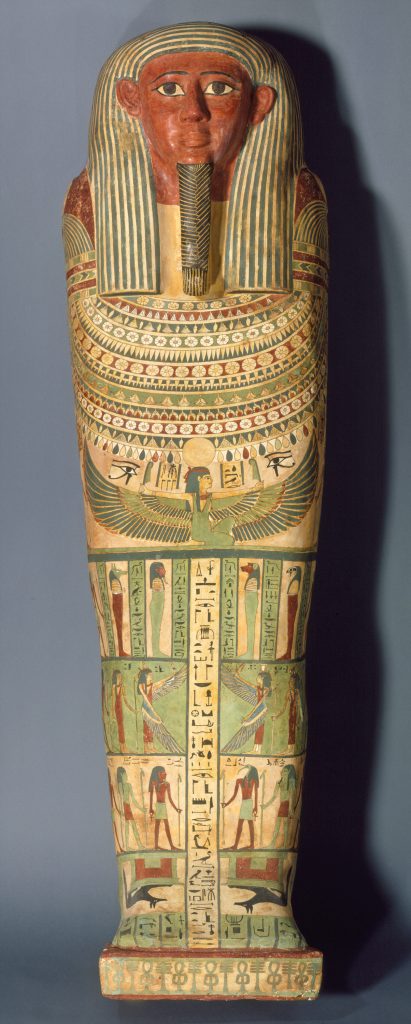Coffin of Amunred (work of art)
Artwork Info
About
Key Ideas about this Work of Art
- Amunred’s coffin is in the form of a human body. It is made of wood and painted with representations of deities, or supernatural beings, who were considered divine or sacred. The hieroglyphic texts painted on the coffin were meant to protect Amunred’s remains.
- Painted across the middle of the coffin is Nut, the ancient Egyptian goddess of the sky and the mother of Osiris. She protected the dead on their journey into the afterlife.
- An idealized likeness, or a perfect representation, of Amunred’s face is painted on his coffin. He has reddish-brown skin and a beard that curls up at the end, and he is wearing a wig. The wig is painted with blue and white stripes stretching across his forehead and falling onto his shoulders. In ancient Egypt, many gods were depicted with beards. Pharaohs (divine rulers) would wear fake beards to signify their status as a living god. Amunred’s beard connects him with immortality.
Learn More
This coffin is decorated with hieroglyphic texts and representations of various deities who protect the remains of the deceased. The central inscription reads: “An offering that the king gives to Osiris, Foremost of the West, Great God, Lord of Abydos, so that he may give a fine burial and offerings to Osiris Amunred, son of Horshefemhat, born to the lady of the house, Isis-Nofret.”
Amunred is the man whose body was mummified and originally placed in the coffin, which is now empty. The name Osiris Amunred can be understood as “the late Amunred.” The inscription associates the name of the deceased with that of the god Osiris, to indicate that Amunred has died and, like Osiris, has been reborn in the afterlife. Amunred is also associated with Osiris because he wears a false beard, which indicates that he has achieved immortality like Osiris.
tags: pattern, function, communication, identity, ritual, survival, ancient Egypt
Additional Resources
Resources for Teachers
- Dig into the details of Amunred’s coffin.
- Learn about the goddess Ma’at.
- Take a look at a step-by-step guide to mummification.
Resources for Students
- Listen to curator Caroline Rocheleau discuss ancient Egyptian coffins and the hieroglyphs on the Coffin of Amunred.
- Learn more about mummies.
- Watch a video to see how mummies are made.


